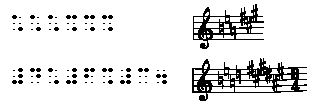|
(Table 3)
A. Accidentals
Signs from Table 3 A.
 Sharp Sharp
 Flat Flat
  Double sharp Double sharp
  Double flat Double flat
 Natural Natural
    Accidental above or below the note Accidental above or below the note
3-1. The sharp, flat and natural signs are placed before the notes, intervals or other
features to which they belong. They must not be separated from notes by anything other than octave marks.
3-2. If an accidental appears above or below a note in print, it is preceded by dot 6 in braille.
3-3. Quarter-step alterations of an accidental are discussed under Modern Notation. See Par. 13-16.
B. Key & Time Signatures
3-4. Key signatures reflect the number of flats or sharps, not the actual pitches as in print. If there are four or more accidentals in a key signature, the number sign is used. See Example 3-8.
3-5. The next note following a key signature must have an octave mark. If it is not followed by a time signature, it must be followed by a space.
3-6. When time signatures consist of an upper and a lower number in print, the braille uses upper- and lower-cell numbers with a number sign only at the beginning of the combination. An upper-cell number is used for a single-digit time signature. In other types of signatures as well, the print is followed closely.
Signs from Table 3 B.
  C or "common" time C or "common" time

  Barred C or "cut" time Barred C or "cut" time

   Time signatures with two numbers Time signatures with two numbers
  4 (or other number) Time signature with single number 4 (or other number) Time signature with single number
3-7. A time signature must be followed by a space, and the next note following it must have an octave mark.
3-8. The key and time signatures are combined with or without one space between, according to the practice of the nation.
Example 3-8.
    One sharp, three-four time One sharp, three-four time
      Four flats, four-four time Four flats, four-four time
3-9. When there is a change of key and/or time signature, the print must be followed exactly. Such a change
is placed between spaces and the next note must have an octave mark.>
Example 3-9.

3-10. When a note appears in a time signature, C is used for the note name, it is shown with its time value, and it is preceded by the music prefix, dots 6, 3. See Example 13-18.
3-11. Some other unusual time signatures are shown in Example 13-19.
16
International Braille Music
15
III. Accidentals, Key & Time Signatures
18
International Braille Music
III. Accidentals, Key & Time Signatures
|